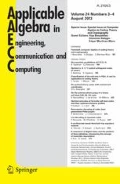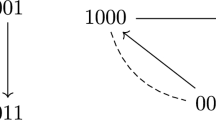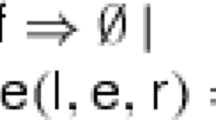Abstract
In this paper, we present how algebraic structures and morphisms can be modelled in the ACL2 theorem prover. Namely, we illustrate a methodology for implementing a set of tools that facilitates the formalisations related to algebraic structures—as a result, an algebraic hierarchy ranging from setoids to vector spaces has been developed. The resultant tools can be used to simplify the development of generic theories about algebraic structures. In particular, the benefits of using the tools presented in this paper, compared to a from-scratch approach, are especially relevant when working with complex mathematical structures; for example, the structures employed in Algebraic Topology. This work shows that ACL2 can be a suitable tool for formalising algebraic concepts coming, for instance, from computer algebra systems.

Similar content being viewed by others
References
Adams, A., et al.: Computer algebra meets automated theorem proving: integrating Maple and PVS. In: 14th International Conference on Theorem Proving in Higher Order Logics (TPHOLs 2001), Lecture Notes in Computer Science, vol. 2152, pp. 27–42 (2001)
Andrés, M., Lambán, L., Rubio, J., Ruiz-Reina, J.L.: Formalizing simplicial topology in ACL2. In: 7th International Workshop on the ACL2 Theorem Prover and its Applications (ACL2 2007), pp. 34–39 (2007)
Aransay, J., Ballarin, C., Rubio, J.: A mechanized proof of the Basic Perturbation Lemma. J. Autom. Reason. 40(4), 271–292 (2008)
Aransay, J., Ballarin, C., Rubio, J.: Generating certified code from formal proofs: a case study in homological algebra. Formal Asp. Comput. 22(2), 193–213 (2010)
Aransay, J., Divasón, J.: Formalization and execution of linear algebra: from theorems to algorithms. In: 23rd International Symposium on Logic-Based Program Synthesis and Transformation (LOPSTR 2013), Lecture Notes in Computer Science (2013) (in press)
Armstrong, A., Struth, G., Weber, T.: Programming and automating mathematics in the Tarski-Kleene hierarchy. J. Log. Algebr. Methods Program. 83(2), 87–102 (2014)
Bailey, A.: The Machine-Checked Literate Formalisation of Algebra in Type Theory. PhD thesis, Manchester University (1999)
Ballarin, C.: Algebraic structures in Axiom and Isabelle: attempt at a comparison. In: Programming Languages for Mechanized Mathematics (PLMMS 2007), number 07–10 in RISC-Linz Report Series, pp. 75–80 (2007)
Ballarin, C., Aransay, J., Hohe, S., Kammller, F., Paulson, L.: The Isabelle/HOL Algebra Library (2013). http://isabelle.in.tum.de/library/HOL/HOL-Algebra/document.pdf
Ballarin, C., Homann, K., Calmet, J.: Theorems and algorithms: an interface between Isabelle and Maple. In: 20th International Symposium on Symbolic and Algebraic Computation (ISSAC 1995). ACM Press, pp. 150–157 (1995)
Bauer, A., Clarke, E.M., Zhao, X.: Analytica—an experiment in combining theorem proving and symbolic computation. J. Autom. Reason. 21(3), 295–325 (1998)
Bishop, E.A.: Foundations of Constructive Analysis. McGraw-Hill, New York (1967)
Brock, B.: Defstructure for ACL2 version 2.0. Technical report, Computational Logic Inc (1997). www.cs.utexas.edu/users/moore/publications/others/defstructure-brock.ps
Capretta, V.: Universal algebra in type theory. In: 12th International Conference on Theorem Proving in Higher Order Logics (TPHOLs 1999), Lecture Notes in Computer Science, vol. 1690, pp. 131–148 (1999)
Castéran, P., Sozeau, M.: A Gentle Introduction to Type Classes and Relations in Coq. Technical report, INRIA (2014). http://hal.inria.fr/hal-00702455
Chyzak, F., Mahboubi, A., Sibut-Pinote, T., Tassi, E.: A computer-algebra-based formal proof of the irrationality of \(\zeta (3)\). In: 5th International Conference on Interactive Theorem Proving (ITP 2014), Lecture Notes in Computer Science, vol. 8558, pp. 160–176 (2014)
Denecke, K., Wismath, S.L.: Universal Algebra and Applications in Theoretical Computer Science. Chapman Hall/CRC, Boca Raton (2002)
Dénès, M., Mörtberg, A., Siles, V.: A refinement-based approach to computational algebra in Coq. In: 3rd International Conference on Interactive Theorem Proving (ITP 2012), Lecture Notes in Computer Science, vol. 7406, pp. 83–96 (2012)
Domínguez, C., Rubio, J.: Computing in Coq with infinite algebraic data structures. In: 17th Symposium on the Integration of Symbolic Computation and Mechanised Reasoning (Calculemus 2010), Lecture Notes in Artificial Intelligence, vol. 6167, pp. 204–218 (2010)
Domínguez, C., Rubio, J.: Effective Homology of Bicomplexes, formalized in Coq. Theor. Comput. Sci. 412, 962–970 (2011)
Dousson, X., Rubio, J., Sergeraert, F., Siret, Y.: The Kenzo program. Institut Fourier, Grenoble (1998). http://www-fourier.ujf-grenoble.fr/sergerar/Kenzo/
Durán, A.J., Pérez, M., Varona, J.L.: The misfortunes of a mathematicians’ trio using computer algebra systems: can we trust? Not. Am. Math. Soc. 61(10), 1249–1252 (2014)
Foster, S., Struth, G., Weber, T.: Automated engineering of relational and algebraic methods in Isabelle/HOL—(Invited Tutorial). In: 12th International Conference Relational and Algebraic Methods in Computer Science (RAMICS 2011), pp. 52–67 (2011)
Garillot, F., Gonthier, G., Mahboubi, A., Rideau, L.: Packaging mathematical structures. In: 22nd International Conference on Theorem Proving in Higher Order Logics (TPHOLs 2009), Lecture Notes in Computer Science, vol. 5674, pp. 327–342 (2009)
Geuvers, H., Pollack, R., Wiedijk, F., Zwanenburg, J.: A constructive algebraic hierarchy in Coq. J. Symb. Comput. 34(4), 271–286 (2002)
Geuvers, H., Wiedijk, F., Zwanenburg, J., Pollack, R., Barendregt, H.: The “Fundamental Theorem of Algebra” Project. Technical report (2000). http://www.cs.kun.nl/gi/projects/fta
Gonthier, G., et al.: A machine-checked proof of the odd order theorem. In: 4th International Conference on Interactive Theorem Proving (ITP 2013), Lecture Notes in Computer Science, vol. 7998, pp. 163–179 (2013)
Greve, D.: Parameterized congruences in ACL2. In: 6th International Workshop on the ACL2 Theorem Prover and its Applications, pp. 28–34 (2006)
Gunter, E.: Doing algebra in simple type theory. Technical Report MS-CIS-89-38, Department of Computer and Information Science, Moore School of Engineering, University of Pennsylvania (1989). http://repository.upenn.edu/cis_reports/789/
Haftmann, F.: Haskell-style type classes with Isabelle/Isar. Technical report, Technische Universität München (2014). http://www.cl.cam.ac.uk/research/hvg/Isabelle/dist/Isabelle2014/doc/classes.pdf
Harrison, J., Théry, L.: A skeptic’s approach to combining HOL and Maple. J. Autom. Reason. 21(3), 279–294 (1998)
Hearn, A.C., et al.: Reduce (2009). http://www.reduce-algebra.com/index.htm
Heras, J.: Mathematical Knowledge Management in Algebraic Topology, chapter An ACL2 infrastructure to formalize Kenzo Higher Order constructors, PhD thesis, University of La Rioja, pp. 293–312 (2011). http://www.unirioja.es/servicios/sp/tesis/22488.shtml
Heras, J., Martín-Mateos, F.J., Pascual, V.: Implementing Algebraic Structures in ACL2. Technical report, University of La Rioja (2012). http://www.unirioja.es/cu/joheras/ahomsia/
Heras, J., Pascual, V., Rubio, J.: A certified module to study digital images with the Kenzo system. In: 13th International Conference on Computer Aided Systems Theory (EUROCAST 2011), Lecture Notes in Computer Science, vol. 6927, pp. 113–120 (2011)
Heras, J., Pascual, V., Rubio, J.: Proving with ACL2 the correctness of simplicial sets in the Kenzo system. In: 20th International Symposium on Logic-Based Program Synthesis and Transformation (LOPSTR 2010), Lecture Notes in Computer Science, vol. 6564, pp. 37–51 (2011)
Jackson, P.: Enhancing the Nuprl Proof-Development System and Applying it to Computational Abstract Algebra. PhD thesis, Cornell University (1995)
Jenks, R., Sutor, R.: AXIOM: The Scientific Computation System. Springer, Berlin (1992)
Journal of Formalized Mathematics. 1990-present. http://www.mizar.org/JFM/
Kaliszyk, C., Wiedijk, F.: Certified computer algebra on top of an interactive theorem prover. In: 14th Symposium on the Integration of Symbolic Computation and Mechanised Reasoning (Calculemus 2007), Lecture Notes in Computer Science, vol. 4108, pp. 94–105 (2007)
Kaufmann, M., Manolios, P., Moore, J.S.: Computer-Aided Reasoning: An Approach. Kluwer, Dordrecht (2000)
Kaufmann, M., Moore, J.S.: Structured theory development for a mechanized logic. J. Autom. Reason. 26(2), 161–203 (2001)
Kaufmann, M., Moore, J.S.: ACL2 version 6.5 (2014). http://www.cs.utexas.edu/users/moore/acl2/
Lambán, L., Martín-Mateos, F.J., Ruiz-Reina, J.L., Rubio, J.: Formalization of a normalization theorem in simplicial topology. Ann. Math. Artif. Intell. 64(1), 1–37 (2012)
Lambán, L., Pascual, V., Rubio, J.: Specifying implementations. In: 24th International Symposium on Symbolic and Algebraic Computation (ISSAC 1999), ACM Press, pp. 245–251 (1999)
Lambán, L., Pascual, V., Rubio, J.: An object-oriented interpretation of the EAT system. Appl. Algebra Eng. Commun. Comput. 14, 187–215 (2003)
Lambán, L., Rubio, J., Martín-Mateos, F.J., Ruiz-Reina, J.L.: Verifying the bridge between simplicial topology and algebra: the Eilenberg-Zilber algorithm. Log. J. IGPL 22(1), 39–65 (2014)
Manolios, P., Moore, J.S.: Partial functions in ACL2. J. Autom. Reason. 31(2), 107–127 (2003)
Martín-Mateos, F.J., Alonso, J.A., Hidalgo, M.J., Ruiz-Reina, J.L.: A generic instantiation tool and a case study: a generic multiset theory. In: 3rd International Workshop on the ACL2 Theorem Prover and its Applications (ACL2 2002), pp. 188–201 (2002)
Martín-Mateos, F.J., Rubio, J., Ruiz-Reina, J.L.: ACL2 verification of simplicial degeneracy programs in the Kenzo system. In: 16th Symposium on the Integration of Symbolic Computation and Mechanised Reasoning (Calculemus 2009), of Lecture Notes in Computer Science, vol. 5625, pp. 106–121 (2009)
Maunder, C.R.F.: Algebraic Topology. Dover, New York (1996)
Maxima, a Computer Algebra system (2012). http://maxima.sourceforge.net
Medina-Bulo, I., Palomo-Lozano, F., Ruiz-Reina, J.L.: A verified Common Lisp implementation of Buchberger’s algorithm in ACL2. J. Symb. Comput. 45(1), 96–123 (2010)
Naraschewski, W., Wenzel, M.: Object-oriented verification based on record subtyping in higher-order logic. In: 11th International Conference on Theorem Proving in Higher Order Logics (TPHOLs 1998), Lecture Notes in Computer Science, vol. 1479, pp. 349–366 (1998)
Pessaux, F., Weia, P., Doligez, D.: The FoCaLiZe essential. Technical report (2010). http://focalize.inria.fr/
Pottier, L.: User contributions in Coq, Algebra. Technical report (2001). http://coq.inria.fr/pylons/pylons/contribs/view/Algebra/v8.4
Romero, A., Heras, J., Rubio, J., Sergeraert, F.: Defining and computing persistent Z-homology in the general case. CoRR, abs/1403.7086 (2014)
Romero, A., Rubio, J.: Homotopy groups of suspended classifying spaces: an experimental approach. Math. Comput. 82, 2237–2244 (2013)
Rubio, J., Sergeraert, F.: Constructive Homological Algebra and Applications. Algorithms, and Proofs. University of Genova, Lecture Notes Summer School on Mathematics (2006)
Rudnicki, P., Schwarzweller, C., Trybulec, A.: Commutative Algebra in the Mizar System. J. Symb. Comput. 32, 143–169 (2001)
Sergeraert, F.: Effective Homology, a Survey. Technical report, Institut Fourier (1992). http://www-fourier.ujf-grenoble.fr/sergerar/Papers/Survey.pdf
Sergeraert, F.: Common Lisp, Typing and Mathematics. Technical report, Institut Fourier (2001). http://www-fourier.ujf-grenoble.fr/sergerar/Papers/Ezcaray.pdf
Spitters, B., van der Weegen, E.: Type classes for mathematics in type theory. Math. Struct. Comput. Sci. 21, 795–825 (2011)
Weibel, C.A.: An Introduction to Homological Algebra, Cambridge Studies in Advanced Mathematics, vol. 38. Cambridge University Press, Cambridge (1994)
Yu, X., Hickey, J.: Formalizing Abstract Algebra in Constructive Set Theory. Technical report, California Institute of Technology (2003). http://authors.library.caltech.edu/27065/
Zippel, R.: The weyl computer algebra substrate. In: International Symposium on Design and Implementation of Symbolic Computation Systems (DISCO 1993), Lecture Notes in Computer Science, vol. 722, pp. 303–318 (1993)
Acknowledgments
The authors would like to thank the reviewers for the useful suggestions andcomments.
Author information
Authors and Affiliations
Corresponding author
Additional information
This work was partially supported by Ministerio de Educación y Ciencia, project MTM2009-13842-C02-01, and by the European Union’s 7th Framework Programme under Grant Agreement No. 243847 (ForMath).
Rights and permissions
About this article
Cite this article
Heras, J., Martín-Mateos, F.J. & Pascual, V. Modelling algebraic structures and morphisms in ACL2. AAECC 26, 277–303 (2015). https://doi.org/10.1007/s00200-015-0252-9
Received:
Revised:
Accepted:
Published:
Issue Date:
DOI: https://doi.org/10.1007/s00200-015-0252-9




